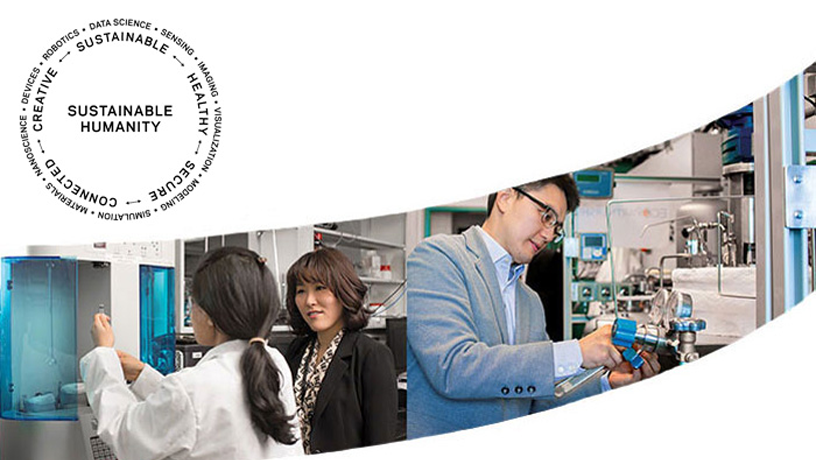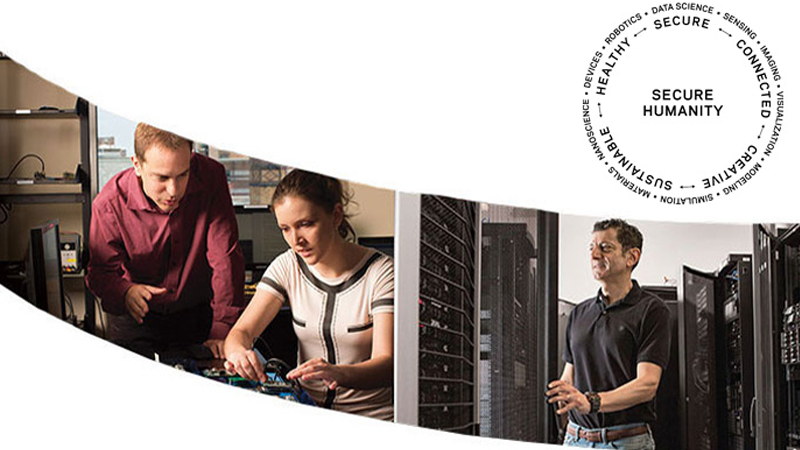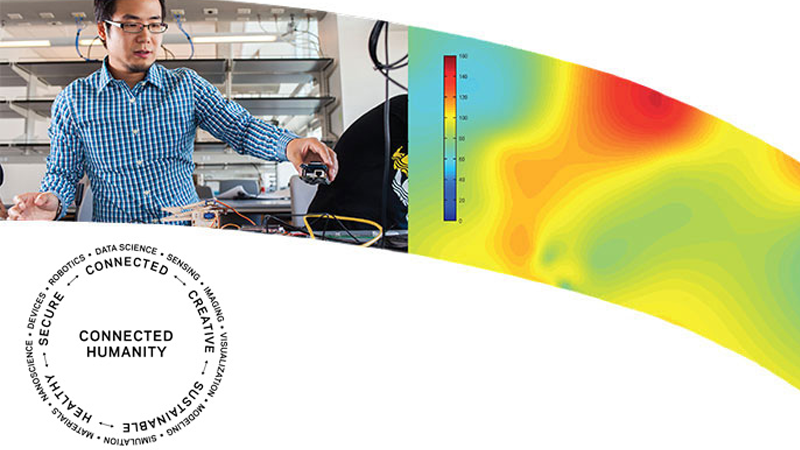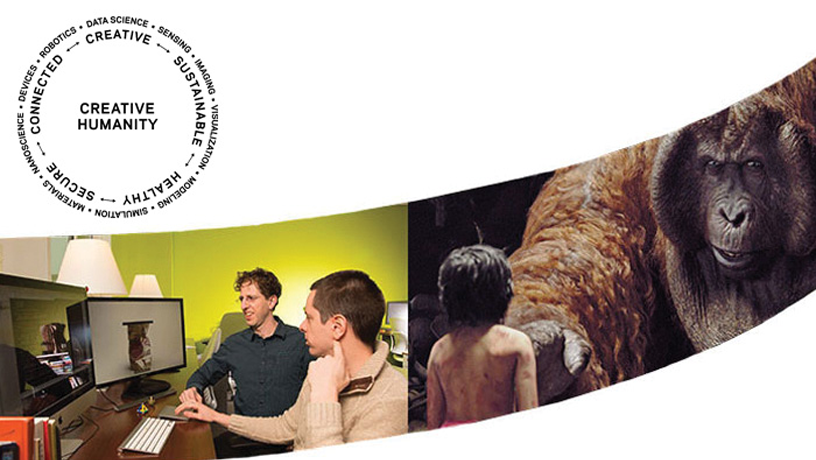Engineering for Humanity
Columbia Engineering: Setting a Vision for the Future
Columbia Engineering recently celebrated its 150th anniversary with a look back at our proud history of discovery and achievement. From its origins as a school devoted to metallurgy and mining, Columbia Engineering contributed to the growth of a rapidly industrializing nation, and its graduates and faculty went on to transform entire industries with developments including steamboat technology, early mechanical tabulators, medical X-ray technology, and FM radio, and to lead such groundbreaking projects as New York's first subway and the world's first nuclear submarine.
Video by Jane Nisselson
Today, Columbia Engineering is continuing that tradition of pushing the frontiers of engineering to address key needs of humanity and setting a bold path forward for the future. As technology moves at a rapid pace and transforms every area of human endeavor, engineering embraces the unprecedented opportunity to bring creative solutions to the challenges of our time.
From sustainable urban infrastructure, such as green rooftops that filter out pollutants and reduce runoff, to intelligent sensor systems that monitor an individual’s energy footprint and provide actionable feedback, we are giving cities and industries the tools to keep the environment healthy. We are pioneering medical imaging techniques, developing methods for connecting people at faster speeds with less energy, creating models for preventing crises and mitigating disasters, and designing technologies to enable creative and artistic expression never seen before.
This spring, we unveil our vision for Columbia Engineering; a vision which reflects our aspirations to bring about innovative research that has a positive impact on humanity—a sustainable, healthy, secure, connected, and creative humanity. Our vision, Columbia Engineering for Humanity, is true to our history as a School and is exemplified today by the diverse and pioneering work that our faculty and students are pursuing across departments and disciplines and in partnership with sister schools, institutes, government, and industry.
We have never been more optimistic about the role engineering can play in the service of society and in bringing those advances to populations across the country and around the world.
We invite you to take a look at Columbia Engineering for Humanity.

Imagine a world where manufacturing waste becomes an asset, mined for valuable resources.
As the global population grows, so does the need for efficient and sustainable use of our planet's limited resources. Billions of tons of solid waste pile up in landfills every year, including toxic byproducts of mining and manufacturing that can cause environmental and health problems. Industries have an opportunity to reclaim value from the waste while preserving the ecological landscape and public health.
For more than a century, faculty and students at Columbia Engineering have pioneered environmentally conscious processes to extend the use of natural resources and increase sustainability. Herbert H. Kellogg BS'41, MS'43, a 20th-century leader in mining sustainability who began his 44-year teaching career at Columbia in 1946, was a passionate advocate for developing the mining industry's environmental awareness. He paved the way for innovative approaches to promote sustainability across disciplines.
That passion for sustainable solutions thrives at Columbia Engineering today. Professor Ah-Hyung (Alissa) Park and Associate Research Scientist Xiaozhou (Sean) Zhou MS'11, MPhil'14, PhD'15 are developing a system to extract valuable materials from slag-the waste of iron and steel production-for use in a range of other industries, including paper, plastic, cement, oil, and gas. These earth and environmental engineers are aiming for a zero-waste future for the industry in partnership with one of the world's largest steel producers. They also aspire to reduce overall carbon emissions by using industrially emitted carbon dioxide as one of the reactants in their process.

Imagine a world where you can measure and record enough neurons in a living brain to understand how the brain drives behavior.
Decoding the human brain is one of the defining challenges of the 21st century and part of the growing emphasis on precision medicine for healthier lives.
Columbia researchers have been improving health care for generations, including developing imaging methods to more safely and precisely direct treatments and improving drug development. In the 1940s, future Columbia Engineering professor and Russ Prize winner Elmer Gaden BS'44, MS'47, PhD'49 took on one of the great challenges of that era-treating infection. For his dissertation, he designed the technology that made possible the mass production of penicillin and other antibiotics.
Today, breakthrough advances in microscopic imaging allow researchers to gain a better understanding of how to detect and treat disease. Professor Elizabeth Hillman of Biomedical Engineering and the Zuckerman Mind Brain Behavior Institute is unlocking the secrets of brain activity with SCAPE, a highspeed 3D microscope she invented for real-time imaging of living organisms, including observing neurons firing inside a living brain. Hillman's team is also developing medical applications for the technology, such as imaging the brain during cancer resection. Their innovations are opening new doors for significant progress in mapping and healing the brain.
The Restless Brain: New Study Uncovers Vivid Patterns of Neural Activity in the Resting Mouse Brain (Credit: Ying Ma and Elizabeth Hillman/Columbia’s Zuckerman Institute)

Imagine a world where power grids are reliable, secure, efficient, and environmentally friendly.
There is no shortage of natural and human-induced factors that threaten the safety and security of humanity: external and internal attacks, extreme weather, financial catastrophes, failing infrastructure, and, increasingly, risks posed by our digital, online world.
Columbia engineers have a rich history of detecting a wide range of security threats and reducing their risks. During World War I, Professor Michael Pupin helped develop sonar technology to increase security for ships. Professor Masanobu Shinozuka PhD'60 of Civil Engineering later became a leading authority on the safety and reliability of structures, particularly their response to earthquakes.
Today, power grids-the pulse of our economies and communities-in particular are under growing stress and subject to catastrophic failure, including disruptions caused by hostile actions. Professor Daniel Bienstock of Industrial Engineering and Operations Research collaborates with Gil Zussman of Electrical Engineering to forge data-driven techniques, mathematical analyses, and algorithmic tools to uncover vulnerabilities in power grids that could be exploited by malicious actors. The same methodologies can be used to diagnose weaknesses that could become dangerous in case of severe natural events, such as major storms, or human errors. Their work aims to prevent the shutdown of power grids and resulting upheaval by designing and making networks that are not only more secure but also more resilient and able to recover faster in the event of a power outage.

Imagine a world where cities are cleaner, healthier, more secure, and more enjoyable.
An estimated 70 percent of the world's population will live in cities by 2050, creating unprecedented demand for clean air, water, energy, food, transportation, and housing. Connectivity is increasingly critical for meeting those needs and analyzing and managing services.
From its very beginning, Columbia Engineering has focused on developing technology and improving systems to help create a more connected world. In 1896, Herman Hollerith, an 1879 graduate, founded a business called the Tabulating Machine Company, which would merge with three other companies to one day become International Business Machines (IBM) Corporation. His business venture was based on a punch card system he had developed to count and sort data mechanically, an invention inspired by his work as a statistician on the 1880 U.S. Census and his belief that there could be a faster way to process data.
Today, data science is increasingly used to understand and explain connections between numbers and people. Assistant Professor Xiaofan (Fred) Jiang of Electrical Engineering and Computer Engineering specializes in the Internet of Things and has been designing sensors to monitor the urban environment-including buildings and infrastructure-to collect and analyze data. In Beijing, he developed a system of low-cost sensors that provided the first independent, real-time assessment of particulate pollution in the city. Along with his Columbia Engineering colleagues Patricia Culligan, the Robert A. W. and Christine S. Carleton Professor of Civil Engineering and associate director of the Data Science Institute, and Andrew Smyth, from Civil Engineering and Engineering Mechanics, Jiang is helping to create smarter, greener cities that will thrive for years to come.

Imagine a world where animation mimics real-world physics and imagination is the only limit to creation.
The creativity of engineers not only makes new technologies possible, it also enables the creativity of others. Former Electrical Engineering Professor Cyril M. Harris, who began teaching at Columbia in 1952, was hailed as "the preeminent acoustical engineer in the United States."
During his career, he fine-tuned or redesigned the sound at more than 100 of America's highest-profile musical venues, including the Metropolitan Opera House and Avery Fisher Hall (recently renamed David Geffen Hall) at New York's Lincoln Center for the Performing Arts.
Today, Computer Science Associate Professor Eitan Grinspun works with Hollywood animation studios and graphic designers to capture the laws of motion in computer algorithms. Computer-generated imagery, or CGI, enchants and delights audiences, yet complex movements and materials can be difficult to represent. Grinspun, who has been active in the development of a new field of geometry, is expanding the ability of moviemakers to portray reality based on physical laws of nature. His work can be seen in Disney's Tangled, Moana, and The Jungle Book, winner of the 2017 Academy Award for Best Visual Effects. Grinspun directs the Columbia Computer Graphics Group, which also creates computational models for geometric modeling and physics-based simulations of materials and structures, from the nanoscale to the macroscale.
Extreme Engineering with Eitan Grinspun: From Computation to Hollywood (Video by Jane Nisselson)
